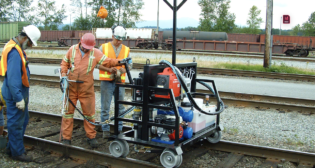
Short Line/Regional Perspective: The case for a railroad retirement tweak
Written by AdministratorBy George Betke, Jr.
 80,000 new hires over a five-year period in order to replace retiring or terminating workers and accommodate projected long-term traffic growth. The challenge of turning over nearly half of a 164,000-member work force is easier said than done. Carriers report difficulty in recruiting training classes for transportation employees and even lower graduation and retention rates—due to family lifestyle considerations, demanding work and conditions, seniority impediments to advancement, and inability to pass required alcohol and drug tests.
80,000 new hires over a five-year period in order to replace retiring or terminating workers and accommodate projected long-term traffic growth. The challenge of turning over nearly half of a 164,000-member work force is easier said than done. Carriers report difficulty in recruiting training classes for transportation employees and even lower graduation and retention rates—due to family lifestyle considerations, demanding work and conditions, seniority impediments to advancement, and inability to pass required alcohol and drug tests.
Railroads must acquire new blood and brains as the existing pool of “old-timers” is depleted. But human resources officials offer discouraging anecdotes of “recruiting 30 for a class of 20, graduating 12 and then keeping five.” Newer hires, who did not expect occasional work, may elect other ways to earn a living by the time the economy recovers. Turnover complicates training demands on all carriers relying heavily on unsupervised workers.
With such scarcity in experienced labor, why should a safety-conscious industry overlook recent retirees as a potential talent pool that could aid the transition to a younger work force? The FRA’s new hours-of-service proposal, calling for a 276-hour maximum work month and no more than six full days without 48 hours of mandated time off, brings this issue into sharper focus, especially for agricultural and other short lines with unusual seasonality. Most short lines don’t have extra boards or reserve forces to be tapped at will to meet demand surges, and many are in rural areas where the supply of reliable unemployed trainmen is sparse at best.
To comply during the annual harvest period, one granger road’s roster of full-time crewmen would need to be expanded by at least 40% with qualified “outsiders.” As a practical matter, three problems arise: (1) Other crop-dependent carriers require similar help at approximately the same time in an industry short of experienced trainmen; (2) Those available, if any, no longer can be hired as contract workers if the employer’s FELA exposure is to be minimized; and (3) The RRB allows retiree annuitants to earn up to $14,160 annually without an offset, but not in their former railroad trade. This curious restriction deprives short lines of occasional help from trained career railroaders with valuable operating skills, knowledge of best industry practices, and understanding of safety risks.
The present 60-years-of-age, 30-years-of-service eligibility standard and related rules governing Railroad Retirement allow a retiree to earn post-retirement income from a railroad as an independent consultant, but the associated criteria reflect the Board’s clear intent to assure a clean break between employee and employer. So the vast majority of railroad retirees can try something different without penalty, but cannot sensibly make productive use of experience gained during their transportation careers without forfeiting previously earned benefits.
The “independence” judgment, based on “smell-test” criteria, includes maintaining a separate workplace, doing business with more than a previous employer, having freedom to schedule assignments, limiting the duration of contracts, and being paid by standards other than time expended. About the only thing a former engineer can do is offer training services, and then only under strict limitations.
Carriers large and small seek out young people, but we ignore those ending full-time employment who still have value to add to our industry. Relative to workers in other businesses, they have retired prematurely; the eligibility age for the rest of society is heading up as productive lifespans are extended and government grapples with Social Security. These veterans represent an attractive labor pool for short lines needing qualified temporaries that can offer a low-stress, part-time working environment with scheduling flexibility. From a safety standpoint, the old-timers could be a positive mentoring influence on newer hands.
Many retired engineers would enjoy being part of a short-line extra board. Their presence would be preferable to adding safety risks by utilizing untrained or less experienced personnel from other departments in temporary train service. Moreover, these part-timers would contribute further to the Railroad Retirement Trust from which they are drawing and pay union dues where applicable.
Why should someone desiring to supplement Railroad Retirement income be forced into a new, unfamiliar activity? It’s a shame that retirees with valuable railroad knowledge become employed elsewhere when their experience could provide aid to an industry that has been their livelihood—a win-win prospect for employers and employees alike.
George Betke is Chief Executive Officer of Farmrail System, Inc. and a member of ASLRRA’s Legislative Policy Committee.



